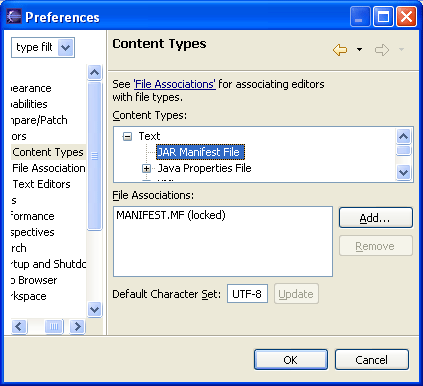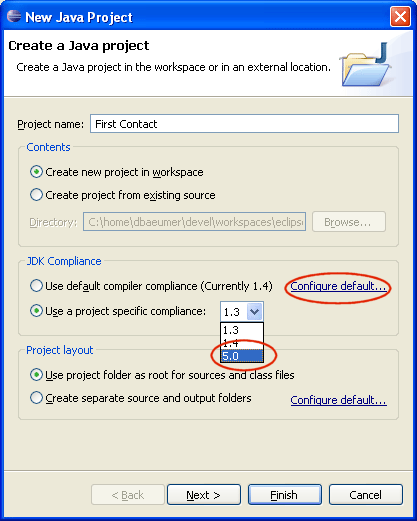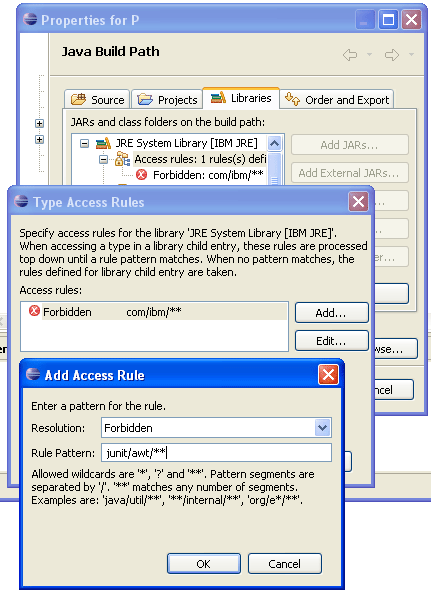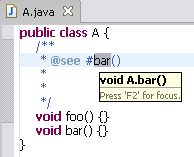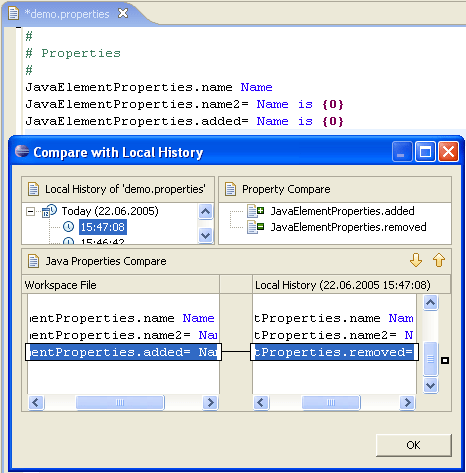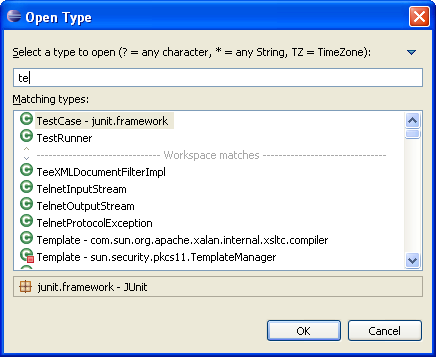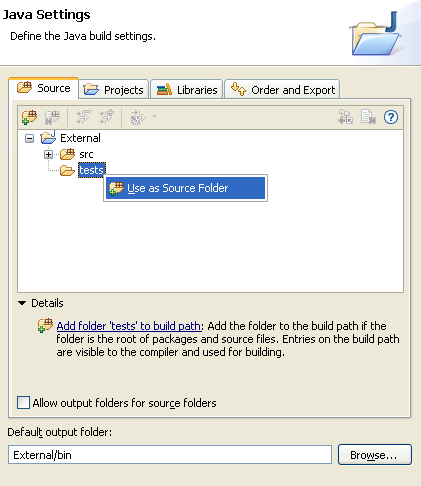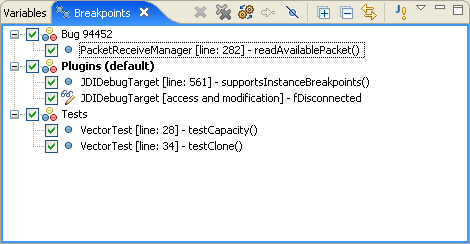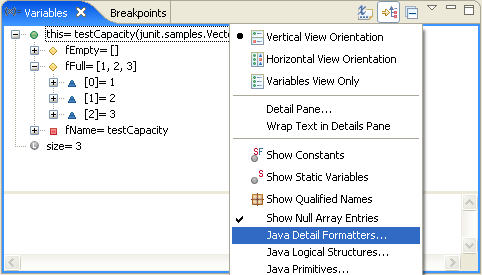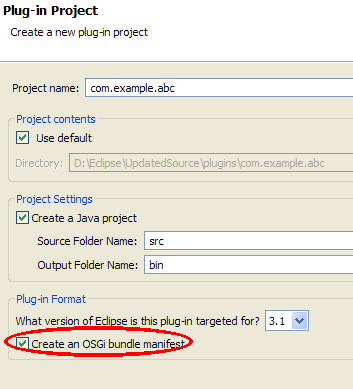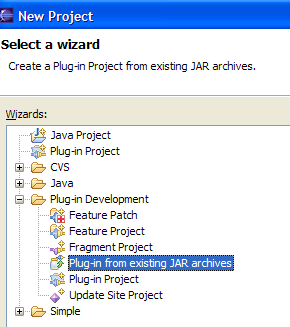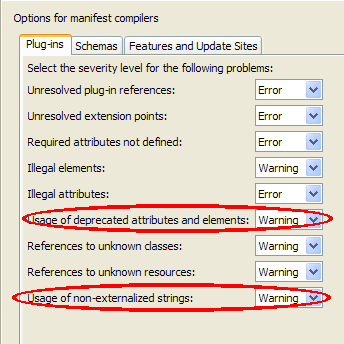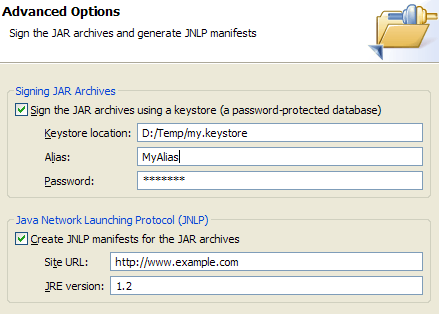Significant Performance Enhancements
Performance has been significantly enhanced across the board since the 3.0 release.
We have also added debugging support that can continually monitor performance while the workbench is running, and have made pervasive benchmarking tests part of the standard test suites. The results of these tests are linked off of the download page for each build. Here is an example of (part of) the output:
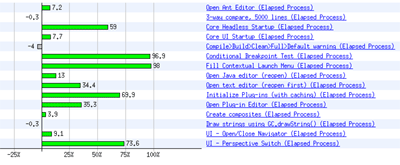
Support for bi-directional text
Support for bi-directional languages (BIDI), has been extended across the platform. Window layout orientation can be configured from the command line, and a suitable default orientation is inferred from the locale. Note that SWT fully supports BIDI on Windows only.
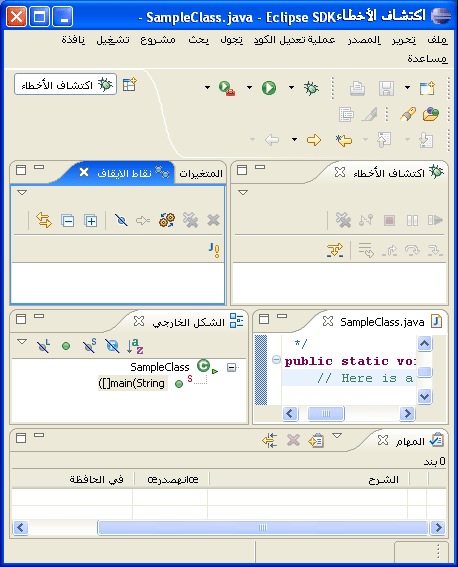
Improved preferences and properties support
You should find preferences and properties significantly easier to work with because of enhancements such as these:
- The Preferences and Properties dialogs now
have a field for filtering the pages displayed to just those that have
names or keywords that match the specified prefix. The example below shows
matches for the keyword "tab".

- Preference pages with related settings are linked together and provide web-style forward and backward buttons (see the screenshot for the next item).
- You now can also navigate to preferences in context. For example, in the editor context menu there is a Preferences... item that shows you the preferences that apply to the current editor.
- The Import/Export wizards now support preferences.
You can choose to import or export all changed settings, or only specific
preferences where supported.
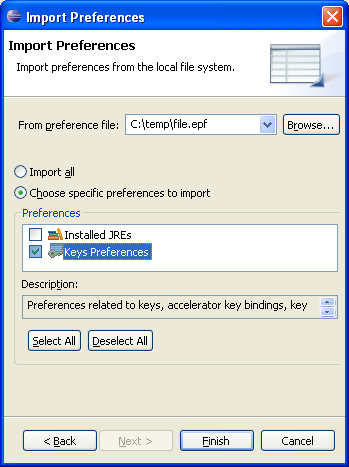
Editor lookup based on content type
When determining the appropriate editor to open for a given file, the file's content type is now taken into account. Editors may now advertise that they are capable of working on certain content types as well as their traditional file name and extensions. A preference page to edit content types and their associated file names and character sets has been added under the General/Editors preference page.
Importing multiple projects
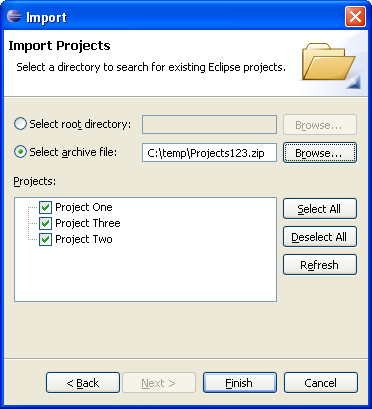
Line delimiter support
You can now set the line delimiter that is used when creating new text files. You can provide a single setting for the entire workspace, or for a given project.
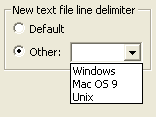
In addition, line delimiter conversions can now be applied to projects, folders, and files, not just to the contents of a single editor.
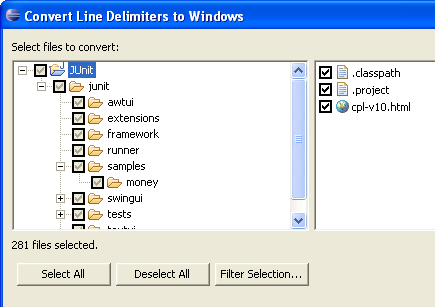
Single JAR plug-ins
Eclipse now provides the ability to ship a plug-in packaged as a single JAR file rather than as a directory of files. Think of this as folding the plug-in metadata (plugin.xml etc.) into its code JAR. This move has a number of benefits ranging from smaller footprint to easier/faster install to fitting better with the standard Java notion of JARs.
In Eclipse 3.1 most plug-ins are shipped as JARs in all distributions. This format is the new best practice for Eclipse packaging.
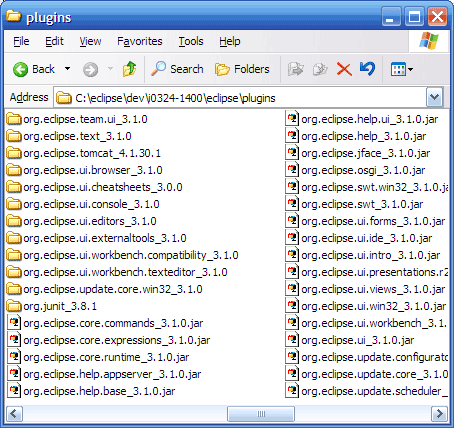
New Editor Features
- Hyperlink support, which was restricted to
the Java editor, has been generalized and moved down to Platform Text. URL
hyperlinking now works in the standard Text editor:

- Text editors now support word completion. In text editors you can complete a prefix to a word occurring in any of the currently open editors or buffers. The default key binding for word completion is Alt+/ (Ctrl+. on the Mac).
- You can now open a text editor without creating a file first. Simply go to File > New > Untitled Text File.
- Many commands that were only
available in other views are now right at your finger tips in the editor
context menu. For example, you can commit files to CVS or run and debug
Java programs and Ant builds from the editor's context menu.

- You can now have more than one editor open on the same file. Use
Window > New Editor to open a second editor of the same type.
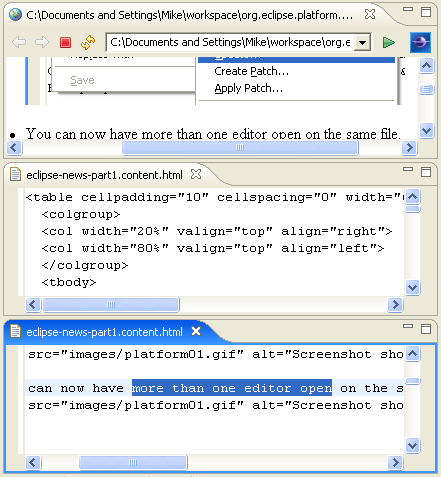
View all keyboard shortcuts

Welcome launch bar

New Help view
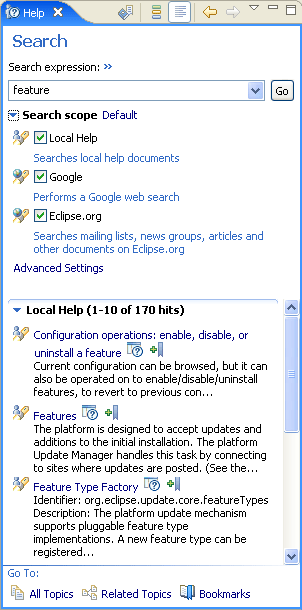
Downloading of updates in background
Update site mirrors

Improved handling of feature dependencies
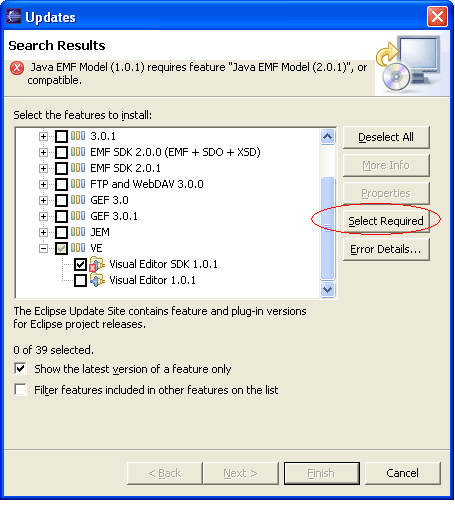
RCP delta pack
SWT Browser widget improvements
Many improvements have been made to the SWT Browser widget. Highlights include:
- On Windows, new windows can now be opened in a stand-alone Internet Explorer browser.
- On Linux, the browser now works with Mozilla 1.7 GTK2 as well as with Mozilla 1.4 GTK2 and above.
- A new execute method passes an arbitrary string of JavaScript commands to be directly evaluated by the underlying native JavaScript engine (Internet Explorer on Windows, Mozilla on Linux, Safari on the Mac) in the context of the HTML document that is currently loaded in the browser widget.

The new Browser Demo example (shown above) illustrates how to integrate HTML content with the SWT Browser widget into an application. The easy way to get the SWT samples is via the new Welcome page.
New spinner widget
org.eclipse.swt.widgets.Spinner.

GC.setLineCap, GC.setLineJoin
GC.setLineCap lets
you control how the end of a line should be drawn (flat, round, or square
styles as shown in the top line of the figure below). GC.setLineJoin
allows you to control how one line attaches to another one in methods
like GC.drawPolylines or GC.drawPolygon. Join
styles are bevel, round, and miter (bottom row)

See the SWT snippet for drawing lines with different cap and join styles.
More platforms being built
Selection clipboard
Native tree with columns
The SWT Tree
widget can now display multiple columns. New API in Tree, TreeItem,
and TreeColumn provides the same support for columns as Table. This
obsoletes the TableTree widget, which is now deprecated.
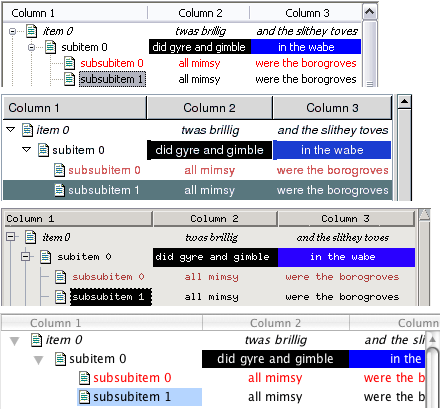
For more details see the example snippet.
Reorderable table columns
The display order of columns in a table can be changed by dragging the column header (as well as being set programmatically).
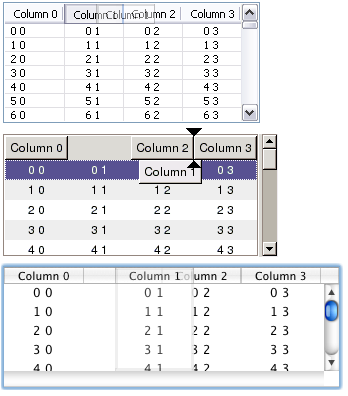
For more details see the example snippet.
Standalone SWT download is now an Eclipse project
For developers of standalone SWT applications, the SWT component is available as a separate download. For Eclipse 3.1, the SWT download can now be easily imported into your workspace as a project.
- Download SWT for standalone applications. A standalone version of SWT is available on the same download page as the Eclipse SDK. Look for the section titled SWT Binary and Source. Do not extract the archive file, just save it to disk.
- Select Import... from the File menu.
- Select Existing Projects into Workspace and click on the Next button.
- Select Select archive file: and use the Browse button to locate the SWT standalone archive you have previously downloaded.
- Click on the Finish button.
The org.eclipse.swt project you have imported defines the location of the native libraries so you can run your application with the standard Java or JUnit launchers.
Starting SWT standalone applications using PDE
To run and debug your SWT application using the SWT plug-in from Eclipse, you can use the new SWT application launcher to locate the native libraries. A shortcut to the launcher is available in the context menu of your Java class via Run As > SWT Application.

Advanced graphics
New API has been added for advanced graphics operations such as path for curves and lines, alpha blending and transformations. This new API requires the Cairo Vector engine on GTK and Motif, and GDI+ on Windows.

For more details see the example snippet.
New Link widget
The new Link
widget displays text containing hyperlinks.

For more details, see the example snippet.
Strike through and underline in StyledText
Text can be underlined or
a strike can be drawn through it with the new StyleRange.underline
and StyleRange.strikeout fields.
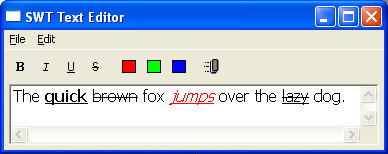
For more details see the example snippet.
CVS outgoing change sets
 in the
Synchronize View, then select an outgoing change and choose Add To
> New Change Set... from the context menu. You can also appoint
a change set as the default and have all subsequent outgoing changes added
to that set automatically. Commands on the context menu allow outgoing
changes to be moved between change sets. When the change set is committed
to the CVS repository, the comment associated with the change set is used
as the CVS commit comment.
in the
Synchronize View, then select an outgoing change and choose Add To
> New Change Set... from the context menu. You can also appoint
a change set as the default and have all subsequent outgoing changes added
to that set automatically. Commands on the context menu allow outgoing
changes to be moved between change sets. When the change set is committed
to the CVS repository, the comment associated with the change set is used
as the CVS commit comment.
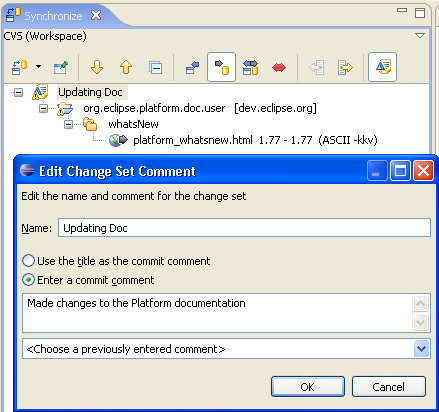
CVS commit review
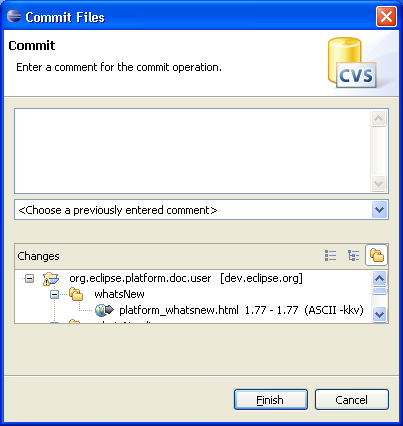
There are also CVS preferences (Team > CVS) for determining whether commit comments are mandatory and for specifying the maximum number of files that should be displayed when committing.
CVS improved file type support
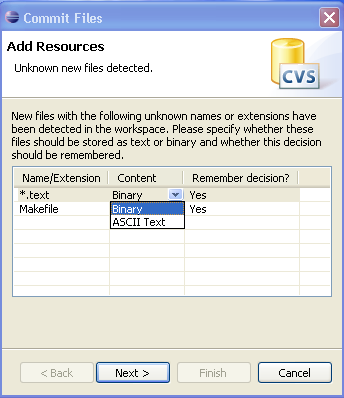
CVS branch and merge

When merging you can simply specify the end tag and the wizard will automatically find the appropriate start tag. If a start tag is not available, you can still merge without seeing a preview in the Synchronize view.
Ant debugger

- System: Ant properties set from the System for the the build
- User: properties such as those set using the -D option
- Runtime: all properties set during the execution of the build
Ant editor improvements
- Support for folding of build file regions. Hovering over a folded Ant element lets you peek at the hidden code. You can quickly control folding presentation of a buildfile from the editor ruler menu (see screenshot below).
- Renaming occurrences of properties and targets within the same buildfile. To activate this use the editor context menu or the Alt+Shift+R keyboard shortcut when the cursor is located within the occurrence to rename.
- Navigating to the referenced target or property via Navigate > Open declaration (F3).
- Opening a browser on the relevant page in the Ant manual by placing your cursor on the name of an Ant task, type, etc. and pressing Shift+F2.
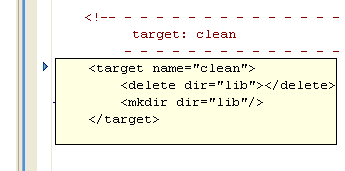
Ant target per build kind
The Targets tab for an Ant builder allows you to specify the target(s) that should be executed for each build kind. This includes the target to execute when you invoke a "Clean".

New features for the Console
- In the Console view you can signal end-of-file to a program waiting for input by pressing Ctrl+Z on Windows (Ctrl+D on Linux).
- You can configure the console to display output using a character encoding different from the default using the Console Encoding settings on the Common tab of a launch configuration.
- Your program's output can now be captured in a file in addition to being written to the console. The behavior is controlled by settings found on the Common tab of launch configurations.
- If you find you need to see multiple consoles at once, you can now open additional Console views via the New Console View command found on the Open Console drop-down menu in the Console view.
